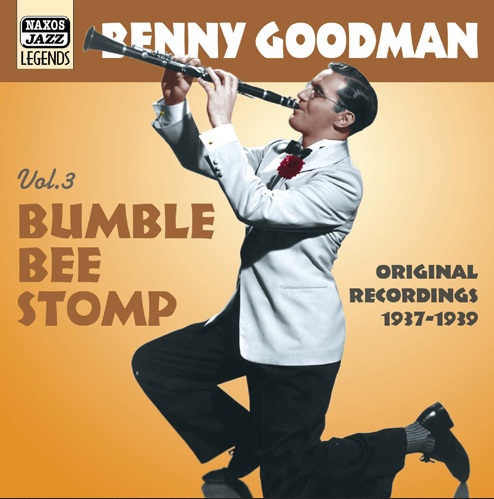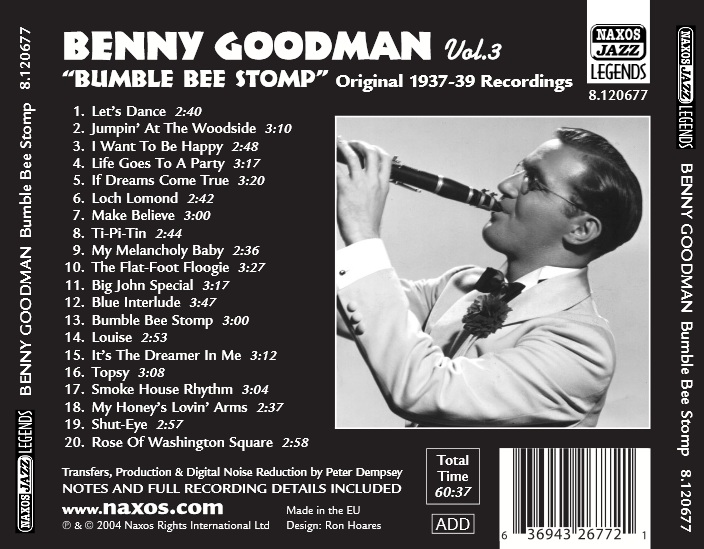Logowanie
Mikołaj - ten to ma gest!
Elton John, The Mamas & The Papas, Cat Stevens, Rod Stewart, Bobbie Gentry, Stevie Wonder, Engelbert Humperdinck
Memory Lane
Edycja Numerowana - 1000 egzemplarzy w skali światowej
RACHMANINOV, Eiji Oue, Minnesota Orchestra
Symphonic Dances / Vocalise
Best Recordings of 2001!!! NAJCZĘŚCIEJ KUPOWANA PŁYTA Z RR!
Karnawał czas zacząć!
Music of Love - Hi-Fi Latin Rhythms
Samba : Music of Celebration
AUDIOPHILE 24BIT RECORDING AND MASTERING
CHOPIN, LISZT, DEBUSSY, DVORAK, Gerhard Oppitz
Dances romantiques - A fantastic Notturno
Wzorcowa jakość audiofilska z Clearaudio
Winylowy niezbędnik
ClearAudio
Double Matrix Professional - Sonic
najbardziej inteligentna i skuteczna pralka do płyt winylowych wszelkiego typu - całkowicie automatyczna
Benny Goodman
Bumble Bee Stomp - Vol.3

- Benny Goodman - clarinet
Original Recordings 1937-1939
"It was by a fortuitous quirk of Fate that Benjamin David Goodman was born on 30 May 1909 in Chicago, for there, during his formative years, he was able to hear at first hand Louis Armstrong, Johnny Dodds and Bessie Smith, as well as Leon Roppolo and Frank Teschemacher. After initial musical training at ten in his local synagogue, at twelve the precocious Benny took up classical clarinet at Hull House School under John Sylvester and also studied privately with Franz Schoepp. At thirteen he was already improvising in jazz and at fourteen he was carrying the card of the American Federation of Musicians and gigging with Bix Beiderbecke on Great Lakes steamboats. In 1925 Benny signed with Ben Pollack in Chicago and went with him to the Venice Ballroom in Los Angeles. He freelanced with Benny Meroff and other bands, but was intermittently a featured soloist with Pollack, in Chicago and elsewhere, until 1929. By 1930 one of New York’s most sought-after session players, he frequently participated on disc in groups fronted by Sam Lanin, Ted Lewis, Red Nichols, Ben Selvin, Joe Venuti et al and in radio studios with André Kostelanetz, Dave Rubinoff, Don Voorhees, Paul Whiteman and others. During 1932 he formed, and played in, a backing group for ill-fated crooner Russ Columbo and by 1934 found himself ideally placed to assess the latest trends in dance-music via the short-lived residency of his sixteen-piece big-band at Billy Rose’s Music Hall. During the summer of 1934 NBC Radio issued a questionnaire to analyse listeners’ tastes and when 18,000 replies overwhelmingly favoured dance music a new programme was devised, entitled Let’s Dance. Organised by pianist-conductor Josef Bonime, the show was sponsored by Nabisco (the National Biscuit Company). Three distinct categories were to be featured on the programme: a commercial ‘sweet’ band, a Latin-American combo and an up-tempo outfit which it was hoped would ‘swing just a little bit more’. This last gave Goodman his coast-to-coast entrée and from December 1934 to May 1935 his band were tuned into by each week by vast audiences of Swing fans. In July 1935 the Goodman band began its first national tour and on 21 August took up residency at the Los Angeles Palomar, from which vantage it quickly acquired first national, then international renown. The band’s next port of residence was the Congress in Chicago (November 1935 to May 1936) and the Swing Era, it has often been claimed, was truly launched when the Goodman band was voted Number One later that year in a Down Beat magazine readers’ poll. ‘The King of Swing’, however, albeit a noted clarinet ace with considerable experience, was a solid rather than a showy virtuoso who had won no particular distinction as a composer or arranger. But in the latter instance, his worldwide recognition had made him a magnet for the best orchestrators, including Jimmy Mundy (1907-1983) and more significantly pianist-bandleader Fletcher Henderson (1897-1952). Henderson’s arrangements were to provide the first boost to Goodman’s popularity when he was forced through economic necessity to sell them to Goodman; and soon afterwards he endorsed the Goodman brand of Swing more fully by becoming Goodman’s full-time staff arranger. Taken under the wing of music-publisher Irving Mills the Goodman outfit, in advance of its first Let’s Dance broadcasts, had cut a few Swing titles for Columbia which at first (in the admissible opinion of Benny’s brother-in-law, the Columbia A & R man John Hammond) ‘did not swing’. By Christmas 1934, however, the combination of Henderson and the rock-solid rhythmic pulse of Gene Krupa on Saturday night radio had converted the youth of America to the new phenomenon. From early 1935, Goodman’s band recorded various numbers which met with instant and unqualified success, including the atmospheric “Blue Moon” with its fine vocal by Helen Ward. The bulk of their material, however, comprised Mills publications for which Goodman received only a flat fee without royalties. Dissatisfied with this arrangement, the ambitious bandleader soon negotiated a better deal – with RCA Victor, who, by a happy coincidence, owned the NBC network that promoted Let’s Dance. He also had an ally in RCA chief executive Ted Wallerstein, who succeeded in securing his ongoing royalty payments. When, in May 1935, Nabisco declined to renew his Let’s Dance contract, Goodman accepted, through MCA, an engagement at New York’s Roosevelt Grill. The Grill’s clientele, however, accustomed to the sweeter tones of Guy Lombardo, rebelled against the ‘unnerving’ Goodman swing, a reaction which prompted Goodman in June, 1935 to take his men on an (at first unsuccessful) MCA-sponsored tour which in turn led to the historic first engagement the Los Angeles Palomar – an event which, broadcast to the American nation, marked the symbolic birthday of the Swing Era. Following the Down Beat poll, by late 1936 Goodman had various hits to his credit (see Naxos 8.120548, Benny Goodman: Swing Favourites, 1935-1936) a catalogue further extended by “Star Dust” (a best-selling instrumental revival of the 1929 Hoagy Carmichael–Mitchell Parish standard, this was coupled with Tommy Dorsey’s version of the same number) and “Bugle Call Rag” (a new arrangement by Henderson of the 1934 Goodman success). Goodman’s 1937 gems of Swing were topped by “Goodnight, My Love” and “This Year’s Kisses”, while “Smoke Dreams”, “Stompin’ At The Savoy”, “Afraid To Dream”, “Peckin”, I Want To Be Happy (a revival from the classic 1924 Vincent Youmans show No, No, Nanette) and a Claude Thornhill up-tempoing of the old Scots ballad Loch Lomond (a rarity insofar as Goodman vocalises, in duet with Martha Tilton) were also the equivalent of ‘hits’ during the period that preceded the setting-up, in 1940, of the US pop charts. Among 1938 jazz items outstanding are a fine Henderson arrangement of Earl Hines’ “Rosetta”, a revival of Jimmy McHugh’s “I Can’t Give You Anything But Love”, Count Basie’s Jumpin’ At The Woodside and the Goodman radio opening signature-tune Let’s Dance. The band’s most commercial bestsellers of 1938 (as interpreted from record and sheet-music sales) included many numbers of a more overtly instrumental inspiration, notably “Sing, Sing, Sing”, Slim Gaillard’s The Flat Foot Floogie, Horace Henderson’s Big John Special, Fletcher Henderson’s Bumble Bee Stomp and Eddie Dunham’s Topsy. In 1939 among its top numbers were Walter Donaldson and Johnny Mercer’s Shut-Eye, Herman Ruby’s My Honey’s Lovin’ Arms (Harry James’ last ‘hit’ prior to quitting Goodman) and the commercial Rose Of Washington Square (originally a vocal item by James F. Hanley interpolated into Ziegfeld’s Midnight Frolics of 1919)." Peter Dempsey, 2004





























